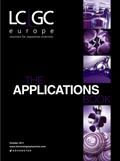Extraction of Opiates From Human Urine Using ISOLUTE SLE+ Columns
Biotage Application Note
This application note describes an optimized and effective supported liquid extraction sample preparation protocol for the extraction of a range of opiates from human urine using ISOLUTE SLE+. Supported liquid extraction is an efficient and cost effective alternative to traditional liquid-liquid extraction (LLE) for bioanalytical sample preparation, providing high analyte recoveries, no emulsion formation and significantly reduced sample preparation time.
Extraction Conditions
This application note outlines the procedure using the ISOLUTE SLE+ 1 mL sample volume column (part number 820-0140-C) optimized for a 1 mL pretreated urine sample volume (other formats are available). Method parameters and dilution factors have been optimized to maximize recoveries and minimize ion suppression.
Sample pre-treatment: To 1 mL of urine add 100 mM ammonium acetate pH 5 (950 µL) and β-glucuronidase (50 µL) enzyme (5000 µ/mL). Hydrolyse with heat in a water bath at 60 °C for 2 hours. Cool and add 25% aqueous ammonium hydroxide (from a 28–30% concentrated solution) (10 µL) and mix.
Sample load: Load pre-treated sample (1 mL) to plate followed by a pulse of vacuum to initiate flow and leave for five minutes.
Analyte elution: Elute with dichloromethane:isopropanol (95:5, v/v) (2.5 mL). Leave to flow under gravity for 5 minutes, then follow with a further aliquot of dichloromethane:isopropanol (95:5, v/v) (2.5 mL), apply a short pulse of vacuum.
Post extraction: Evaporate to dryness at room temperature (80 L/min) and reconstitute in 0.1% formic acid (aq) (500 µL).
Analytical Conditions
Instrument: Waters Acquity UPLC interfaced to a Quattro Premier XE triple quadrupole MS using electrospray ionization
Column: Acquity BEH C18 100 × 2.1 mm × 1.7 µ
Mobile phase: A: 0.1% formic acid (aq)
B: 0.1% formic acid in methanol
For gradient see Table 1
Flow-rate: 0.40 mL/min
Injection: 15 µL (partial loop, needle overfill)
Sample temp: 20 °C
Column temp: 40 °C
Source temp: 150 °C
Desolvation temp: 450 °C
Results
Sample recoveries of over 90% for all analytes except 6-monoacetylmorphine (>70%) with RSDs below 10% were achieved at 2 ng/mL LOQ. Figure 1 shows the mass chromatogram for morphine.

Table 1: UPLC Gradient.
Conclusions
This method demonstrates a robust and effective extraction of a full range of opiates from the challenging biological matrix of human urine with hydrolysis. A significantly lower LOQ than 2 ng/mL could be achieved with more sensitive mass spectrometry and/or lower reconstitution volumes.

Figure 1: Example mass chromatogram for morphine extracted at 2 ng/mL.
References
1. R. Jones, L. Williams et al., Application Note AN741 (available from www.biotage.com/applications).
Biotage AB
Kungsgatan 76, SE-753, 18, Uppsala, Sweden
tel: +46 18 56 59 00 fax: +46 18 59 19 22
E-mail: info@biotage.com Website: www.biotage.com

USP CEO Discusses Quality and Partnership in Pharma
December 11th 2024Ronald Piervincenzi, chief executive officer of the United States Pharmacoepia, focused on how collaboration and component quality can improve worldwide pharmaceutical production standards during a lecture at the Eastern Analytical Symposium (EAS) last month.
RAFA 2024: Giorgia Purcaro on Multidimensional GC for Mineral Oil Hydrocarbon Analysis
November 27th 2024Giorgia Purcaro from the University of Liège was interviewed at RAFA 2024 by LCGC International on the benefits of modern multidimensional GC methods to analyze mineral oil aromatic hydrocarbons (MOAH) and mineral oil saturated hydrocarbons (MOSH).